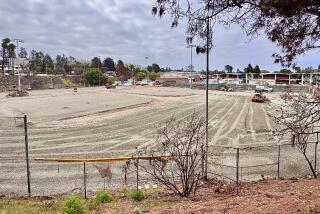Plan to finance new Garfield High auditorium approved
- Share via
A plan to finance the rebuilding of Garfield High School’s historic auditorium won approval from the Board of Education on Tuesday, improving the chances that the fire-damaged building in East Los Angeles might once again become a center of activity for students and the community.
If and when the project comes to fruition, Garfield would gain a new auditorium featuring a cutting-edge theater facility as well as a new, more functional 58,000-square-foot administration building with improved classroom and laboratory space. The estimated cost of the project is $54 million.
Tuesday’s unanimous vote authorizes the Los Angeles Unified School District to complete a design as well as environmental studies, which would come back to the board for final approval in May or June, officials said. The timetable calls for demolition to begin this summer, when students are out of classes, and new construction to begin in summer 2011.
Some students and staff probably would have to be placed in temporary, portable classrooms and offices. If on target, the buildings would be completed by September 2012.
“This moves us forward in terms of reconstruction of their auditorium and the adjacent building, which has been stalled for three years,” said board member Yolie Flores, whose district includes Garfield. “It’s been frustrating. But at least we can get kids the auditorium and facilities they need.”
The district is proposing to finance the project by issuing Certificates of Participation, which would eventually be repaid with future insurance payments, privately raised funds and other bond or capitol money. Initial phases of the project, however, would require general funds.
The auditorium was gutted in a May 2007 arson fire that also damaged the attached main office wing.
The building was insured, but the district and nine insurers have been at odds over the scope of reconstruction. L.A. Unified argues that to meet state codes, the 1925 auditorium must be rebuilt from the ground up; insurers insist that some of the burned-out shell is salvageable, according to district officials.
Mediation between the two sides has not resolved the issue. The insurance companies have declined through their attorney, Jess B. Millikan, to comment on the insurance claim. Insurers have made some payments that have covered the costs of initial designs, said Neil Gamble, the district’s interim director of construction.
Officials said moving ahead with a new financing plan while also proceeding with an insurance settlement -- that could take years -- would allow Garfield students to more quickly regain space for assemblies, musical performances, plays and other activities that have been conducted on a makeshift basis for the last three years.
Garfield Principal Michael B. Summe said Tuesday’s board vote was a hopeful sign.
“This shows that the district is committed to putting this together first and not putting the insurance settlement in front of it,” said Summe, who attended the board meeting. “There is a concrete plan for moving on, starting with the demolition this summer and putting up bungalows and other things needed on campus so that we can move people out. There will be some discomfort, but it is the right thing to do.”
Ellen Sell, formerly lead teacher in the school’s performing arts academy, said it has been hard for students and staff to adjust to a campus with no functioning auditorium. Dance classes have been held in an auto shop with a concrete floor and students have been forced to use the noisy gym as a gathering place, said Sell, who retired in June after 25 years at the school.
The auditorium, which could seat 1,500 people, was also a center of community activity in its tough Eastside neighborhood, hosting meetings and other events. Sell said that plans for the new auditorium include spaces for work, storage and a dance studio among other features.
“It would be so nice to have a really good auditorium,” said Sell, who also attended the board meting. “Eastside schools are the only performing arts spaces in those communities.”
More to Read
Sign up for Essential California
The most important California stories and recommendations in your inbox every morning.
You may occasionally receive promotional content from the Los Angeles Times.














